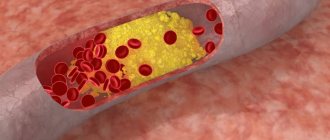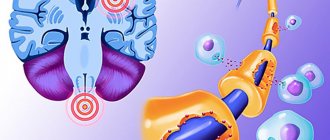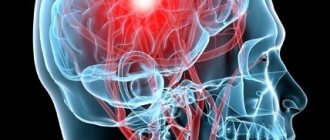Diagnostics
To determine multiple sclerosis, doctors use interviews and neurological examinations, and then confirm the diagnosis with MRI studies and tests.
MRI scans the brain and spinal cord for old and new lesions. For better visualization of fresh plaques, contrast is used. The diagnosis is made if the patient has 4 or more foci of demyelination measuring at least 3 mm, or 3 foci near the lateral ventricles, in the brain stem, cerebellum or spinal cord. In addition to MRI, the following may be prescribed for multiple sclerosis:
- regular blood tests to determine the level of immunoglobulins in the cerebrospinal fluid;
- lumbar punctures to study the composition of the spinal cord fluid.
How to stop multiple sclerosis: treatment of different forms of the disease
Unfortunately, despite progress in MS therapy, it is not yet possible to completely defeat the disease. However, if a person has multiple sclerosis, treatment can help reduce symptoms and reduce the number of relapses. Therapy is prescribed depending on the severity of the disease.
For progressive forms of MS, treatment can help reduce the severity of the disease. Specialists can prescribe:
- plasmapheresis - purification of the patient's blood;
- immunosuppressants - drugs that artificially suppress the immune system;
- immunomodulators are medications that regulate the body's immune response.
To prevent relapses, B-interferons can be used, and to reduce the intensity of symptoms, the following are used:
- vitamins E and B complexes;
- nootropics that improve brain activity;
- anticholinesterase drugs that inhibit the activity of the nervous system;
- muscle relaxants that help reduce muscle tone;
- enterosorbents that help remove toxins.
A cold object felt like it was hot
Alexander Zakharov is 35 years old, he is a private design engineer. They say about such people: a man is in the prime of his life - he adheres to a healthy lifestyle, has never smoked or drank, plays sports and dances, eats right. He has also been battling multiple sclerosis for several years.
“The disease first made itself felt four years ago. I noticed that if you touch your leg with a obviously cold object, it feels as if it is hot. I was not diagnosed right away. At first, a neurologist from a private clinic said that it was a radicular syndrome and suggested taking medication, but it didn’t get better. Then another neurologist, hearing what I was being treated with, grabbed my head and sent me for an MRI of my head, neck and back. And then the details of my diagnosis gradually began to become clear,” says Alexander.
Since Alexander was told what he would face, he has learned a lot about methods of treating his illness both in Russia and abroad. But he tries not to dwell on his illness and continues to live life to the fullest. I just had to make some minor adjustments to it.
“When I went to the hospital for the first time, I very clearly felt that my life could continue for a relatively long time, or could end right during this treatment, since the body is able to react to it differently. Since then I have lived with this feeling. Therefore, I want to live the remaining time joyfully, with pleasure, and see as much as possible. My wife and I tried to travel before, but now it’s one of our goals. In the summer I have a lot of orders, and in the winter we will go somewhere warm and travel. Even our child is studying remotely. And I asked my wife to find a job right now that can be done from home. She learned how to make custom websites from ready-made blocks,” shares Alexander.
In addition, the man tries to provide himself with a financial backlog and actively saves money - in case the family is not left without a livelihood if he suddenly cannot work. In addition, since Alexander is a professional engineer, he immediately began rebuilding his house in order to create comfortable conditions for himself for the time when he could no longer move independently.
“At first, when I found out about my illness, I wanted to prepare the house for the possibility that I might end up in a wheelchair. I live in my private house in the Moscow region and intended to rebuild the first floor, make a ramp for a wheelchair, and so on. But as a result, I limited myself to minor alterations. I came to the conclusion that even if the illness began to attack quickly, I would still have time to rebuild everything. And if it’s fast, then it won’t be needed anymore. Now I’m thinking that maybe we won’t live in this house, and all this won’t be useful. I am seriously thinking about changing my place of residence and moving to another country. I work remotely anyway,” the man shares his plans.
Rehabilitation for multiple sclerosis
- Physiotherapy.
Exercise therapy helps improve a person’s condition with impaired motor activity. Working out on exercise machines helps restore coordination of movements. With correctly selected loads, the method demonstrated excellent efficiency. - Physiotherapy.
For patients with MS, electrophoresis, myostimulation, ultrasound, and magnetic therapy are recommended. These techniques help to activate the body's metabolic processes and reduce inflammation. - Massage.
For multiple sclerosis, this rehabilitation method can be used to relieve pain symptoms and spasms. Massage also helps improve muscle tone when it decreases.
Rehabilitation for multiple sclerosis also includes psychotherapy, which will help the patient cope with negative thoughts, as well as consultations with a nutritionist.
Disease prognosis
Multiple sclerosis is not considered a fatal disease; the unpleasant symptoms of MS can be quite successfully treated. Scientists have found that thanks to modern treatment, the life expectancy of patients today has increased significantly compared to those who fell ill even a few decades ago.
Overall, people with multiple sclerosis live on average 7 years less than the general population. Often, a decrease in life expectancy is associated with complications of other pathologies: cancer and cardiovascular diseases. For many patients, quality treatment can prevent a decline in quality of life and productivity. According to the National Multiple Sclerosis Society, ⅔ of people with MS are wheelchair-free even 20 years after diagnosis.
Disability in multiple sclerosis
| If multiple sclerosis has caused disability for 5 months or more within a year, the patient can apply for disability registration. |
After reviewing the documents, the commission will make a decision on incapacity for work, which gives the right to receive a pension and preferential working conditions. The establishment of a disability group is influenced by:
- the period for which the ability to work was lost;
- the period when the patient was registered with this disease;
- frequency, duration and severity of exacerbations;
- therapy results;
- changes in the course of the disease, the rate of development of symptoms.
Disability is assigned for a year, after which it is necessary to pass the commission again. Disability of groups I and II with MS gives the right to a reduced working day - 35 hours per week. In this case, wages are paid in full.
Multiple sclerosis and symptoms in men - consequences and treatment
Content:
Types of multiple sclerosis Possible causes of sclerosis Clinical course of multiple sclerosis Diagnosis of multiple sclerosis Symptoms of the disease Consequences of multiple sclerosis for a sick man Forecasts for recovery
Every year, more and more men are diagnosed with a disease such as multiple sclerosis, which is currently incurable, and early therapy will help reduce the number of relapses and improve the quality of life.
Multiple sclerosis is a disease in which the entire neural process of the brain and spinal cord is disrupted, resulting, over time, in a completely frail state. The prerequisite for this process is the death of the membrane of nerve nodes and endings. Multiple sclerosis is an autoimmune pathology and, when it develops, affects healthy brain cells and nerve endings. With the development of this disease, men experience problems such as a gradual loss of sensation in the arms and legs, a swaying gait, decreased vision, urinary incontinence, facial asymmetry, constant nervous tension and an unstable emotional background.
Doctors, even in our time, have not yet found out what is the prerequisite for this disease, but they adhere to several main arguments - this is an incorrect lifestyle, food and ecology.
Multiple sclerosis in men brings irreversible results to the male body, and timely and accurate diagnosis is necessary for subsequent treatment of this disease with the necessary care for the unhealthy person.
Statistics show that women between 30 and 40 years of age are most at risk of developing multiple sclerosis. Men suffer from multiple sclerosis much less often. This disease is not synonymous with senile sclerosis and has no age restrictions.
When a disease occurs, scars appear on the nerve endings, reduce sensitivity and reactions to what is happening, stop a person’s intellectual work, destroy memory and stop the functioning of neurons.
The hidden development of this disease does not make it possible to detect it in a timely and complete manner, and often, when it is already diagnosed, therapy begins very late, which gives only a temporary therapeutic effect.
With rapid treatment of this pathology, the disease can, if not be cured, then be completely stopped at the stage of development, which will make it possible to preserve brain activity and important human organs.
Types of multiple sclerosis
Each disease has types and subtypes, and all of them proceed differently, due to their characteristics and have their own symptoms.
- Isolated clinical form of multiple sclerosis. This type of course is a certain type of multiple sclerosis disease and has some of its own pathology from all other types.
- The relapsing-remitting form of multiple sclerosis is a common type of disease progression, which is determined by alternating remission and progression of the disease. During life, which periods can be extended over years, these stages can alternate. It is very difficult to predict the stages of development. Perhaps the occurrence of one or another stage is influenced by the external circumstances of the patient. During calm, remission, the altered cells of the brain and organs are completely restored and improve the state of brain activity.
- Secondary progressive multiple sclerosis. With all this type of sclerosis pathology, severe damage to the human Central Nervous System occurs. There is a constant progression of the disease without remission.
- Remitting progressive multiple sclerosis. With this type of pathology of multiple sclerosis, a sharp development of the disease occurs. During remission, the processes of destruction of the central nervous system, continuing to destroy a person’s personality, do not stop and affect the functioning of internal organs and the brain.
- Primary progressive multiple sclerosis is a disease with such a course, it constantly acts progressively, increasing the lesions of the brain and central nervous system, and has a powerful effect on the functioning of the internal organs of a person.
With the development of multiple sclerosis, regardless of its gradation, it does not seem likely to make a prognosis for the course of multiple sclerosis. Because in the initial stage, when symptoms have already appeared, they are not pronounced and may correspond to various types of this disease.
The relapsing type of progression is the most common type of multiple sclerosis, which is easily cured in the early stages.
Naturally, healing depends on the characteristics of each person, genetics, immune system, and the body’s ability to regenerate.
Official medicine divides multiple sclerosis into a malignant type and a benign type.
- With the benign type, the disease develops without symptoms, the so-called latent type, which can last from 10 to 30 years.
- With malignant development, multiple sclerosis disease develops very quickly; in one year, these hidden processes can lead the human body to disability.
Possible causes of sclerosis
Scientists around the world still cannot say the cause of multiple sclerosis in the human body. And what starts this process. But there are suggestions that the main trigger for triggering this disease is the unfavorable environmental environment in which a person is located, poor nutrition, great emotional and physical stress, a person being in a state of constant stress, genetic predisposition, alcohol and nicotine addiction, improper work immune, lymphatic and other body systems. But this process is triggered by a combination of these and other factors that worked simultaneously.
Clinic for the course of multiple sclerosis disease
Due to damage to the brain and spinal cord of the body, a man’s physical and mental abilities decrease. The quality of life changes dramatically; he can no longer cope without outside help. Which is psychologically uncomfortable for him. In severe cases, complete paralysis of the body is possible, which requires only pastel mode. In this case, physical therapy is necessary to restore full or partial physical activity.
Diagnosis of multiple sclerosis
Multiple sclerosis is diagnosed according to an analysis of hereditary predisposition, as well as according to an examination by a neurologist, with indicators confirming the diagnosis. Also, a complete picture will be shown by an MRI of the brain with the introduction of a contrast agent, which clearly shows plaques in the brain, which clearly confirm this diagnosis. They also use special electrical stimulation that monitors the conduction of impulses from different groups of nerves. By examining the cerebrospinal fluid, it is possible to diagnose hidden viruses and infections that develop in the brain tissue and reflect their effect on the entire body. It is also necessary to conduct studies on the level of immunoglobulins and leukocytes. With the combined data of an extensive study, an accurate diagnosis can be made.
Symptoms of the disease
Symptoms may vary for each man, depending on what part of the body is affected. Also, symptoms may disappear and appear at different times, and manifest themselves in different ways. But there are common features of this disease that exist in official medicine:
- loss of some degree of sensation in the arms and legs;
- instability of vision, then its loss, then restoration;
- clumsiness and unsteadiness of gait;
- periodic headaches and dizziness;
- impotence and urinary incontinence.
If treatment is completely refused, a man may become completely blind, swallowing and speech functions will disappear, mental abilities and adequacy of behavior will be lost, and dementia will be detected.
If such symptoms are detected, urgent resuscitation and removal from a critical situation are necessary.
Consequences of multiple sclerosis for a sick man
With early diagnosis and competent ongoing therapy, a man can live a happy, harmonious, almost healthy life. But with late diagnosis, unwillingness to be treated, or improperly selected therapy, multiple sclerosis can lead to death due to failure of internal organs, although this disease is not fatal.
Recovery forecasts
It is impossible to predict how the disease will behave at different stages, with different methods of therapy. But you need to help your body in addition to drug treatment to increase immunity and relieve symptoms, use methods such as proper nutrition, give up alcohol and smoking, it is advisable to stop eating red meat, undergo psychotherapy, yoga and Ayurveda help in the early stages. A special massage will also be very effective. Physiotherapy with currents is also effective. Acupuncture. Blood purification procedures are carried out. Perhaps hormonal therapy and taking antioxidants will help. It’s difficult to say which treatment method will help, but the main thing is not to give up and not allow yourself to be left to the will of doctors and life. We must continue to live, do what we love, and help people. Lead an active life as much as possible, which is very important for every man. Help from loved ones is very important with this syndrome. Therefore, if it is not there, you need to go to a special clinic or invite a specialist who knows how to provide assistance to such patients.
Some clinics provide treatment by relieving symptoms, drug treatment is aimed at strengthening the body's protective functions, and physiotherapy is performed. There is psychological help to help a person get out of a state of impasse. Group physical exercises, which are specially designed to train certain muscle groups and ligaments, are perceived by sick people very joyfully. This includes communication with people who are familiar with this disease and training.
Treatment of multiple sclerosis with folk remedies has not been studied or proven. Therefore, resorting to it is quite risky. But it is possible to study this topic. And if one of the methods has been tested by other patients and received a positive assessment, it should be used only after consultation with the attending physician.
Scientists are developing new treatment principles every year, and the process of finding a treatment method does not stop. Therefore, in the near future, a disease such as multiple sclerosis in men will be easy to treat. And she will leave the list of incurables.
Diagnostics
Instrumental research methods make it possible to identify foci of demyelination in the white matter of the brain. The most optimal method is MRI of the brain and spinal cord, which can be used to determine the location and size of sclerotic lesions, as well as their changes over time.
In addition, patients undergo an MRI of the brain with the introduction of a gadolinium-based contrast agent. This method allows you to verify the degree of maturity of sclerotic lesions: active accumulation of the substance occurs in fresh lesions. MRI of the brain with contrast allows you to determine the degree of activity of the pathological process. To diagnose multiple sclerosis, a blood test is performed to determine the presence of an increased titer of antibodies to neurospecific proteins, in particular to myelin.
In about 90% of people with multiple sclerosis, oligoclonal immunoglobulins are detected in cerebrospinal fluid tests. But we must not forget that the appearance of these markers is also observed in other diseases of the nervous system.
Benign MS
It proceeds with a favorable outcome. The disease begins rapidly, with frequent attacks and severe symptoms. Then the exacerbation is replaced by remission (attenuation). Subsequently, remissions become longer, and the myelin on the nerve fibers has time to fully recover. This is also facilitated by properly selected treatment and optimal motor mode. It is the benign variant that accounts for cases of healing from multiple sclerosis. Unfortunately, this happens infrequently, in only 20% of cases.
Preventive measures
Prevention of multiple sclerosis is a set of measures that are aimed at eliminating provoking factors and preventing relapses.
The constituent elements are:
- Maximum calm, avoidance of stress and conflicts.
- Maximum protection (prevention) from viral infections.
- A diet, the obligatory elements of which are polyunsaturated fatty acids Omega-3, fresh fruits and vegetables.
- Therapeutic exercises - moderate loads stimulate metabolism, creating conditions for the restoration of damaged tissues.
- Performing anti-relapse treatment. It should be regular, regardless of whether the disease manifests itself or not.
- Excluding hot food from the diet, avoiding any thermal procedures, even hot water. Following this recommendation will prevent the appearance of new symptoms.
Predictions and consequences
Multiple sclerosis, how long do you live with it? The prognosis depends on the form of the disease, the time of its detection, and the frequency of exacerbations. Early diagnosis and prescription of appropriate treatment ensure that the sick person practically does not change his lifestyle - he works at his previous job, actively communicates and the signs are not noticeable outwardly.
Prolonged and frequent exacerbations can lead to many neurological disorders, resulting in a person becoming disabled. We should not forget that patients with multiple sclerosis often forget to take medications, and their quality of life depends on this. Therefore, the help of relatives in this case is irreplaceable.
In rare cases, an exacerbation of the disease occurs with a deterioration in cardiac and respiratory activity, and the lack of medical care at this time can lead to death.
Experimental drugs
Some doctors have reported benefits from low (up to 5 mg at night) doses of naltrexone, an opioid receptor antagonist, which has been used to reduce symptoms of spasticity, pain, fatigue, and depression. One trial showed no significant side effects of low-dose naltrexone and a reduction in spasticity in patients with primary progressive multiple sclerosis. Another trial also noted improvements in quality of life based on patient surveys. However, too many study dropouts reduce the statistical power of the clinical trial.
The use of drugs that reduce the permeability of the BBB and strengthen the vascular wall (angioprotectors), antiplatelet agents, antioxidants, inhibitors of proteolytic enzymes, drugs that improve the metabolism of brain tissue (in particular, vitamins, amino acids, nootropics) is pathogenetically justified.
In 2011, the Ministry of Health and Social Development approved the drug Alemtuzumab, Russian registered name Campas, for the treatment of multiple sclerosis. Alemtuzumab, currently used to treat chronic lymphocytic leukemia, is a monoclonal antibody against the CD52 cell receptor on T lymphocytes and B lymphocytes. In patients with early-stage relapsing-remitting multiple sclerosis, Alemtuzumab was more effective than interferon beta 1a (Rebif), but there was a higher incidence of severe autoimmune side effects such as immune thrombocytopenic purpura, thyroid disease, and infections.
The website of the National Multiple Sclerosis Society in the USA regularly publishes information about clinical trials and their results. Since 2005, bone marrow transplantation (not to be confused with stem cells) has been effectively used to treat MS. Initially, the patient is given a course of chemotherapy to destroy the bone marrow, then donor bone marrow is transplanted, and the donor blood passes through a special separator to separate red blood cells.
Up-to-date information about clinical trials of drugs for the treatment of multiple sclerosis conducted in the Russian Federation, the timing of their implementation, protocol features and requirements for patients can be found on the portal of the Institute of Medical Chemistry of the Russian Academy of Sciences.
In 2021, Russian scientists announced the development of the first domestic drug for patients with multiple sclerosis. The effect of the drug is maintenance therapy, allowing the patient to be socially active. The drug is called Xemus and will appear on the market no earlier than 2021.
What it is?
Multiple sclerosis is a chronic autoimmune disease that affects the myelin sheath of nerve fibers in the brain and spinal cord. Although in colloquial speech “sclerosis” is often referred to as memory impairment in old age, the name “multiple sclerosis” has nothing to do with senile “sclerosis” or absent-mindedness.
“Sclerosis” in this case means “scar”, and “scattered” means “multiple”, since the distinctive feature of the disease during pathological examination is the presence of sclerosis foci scattered throughout the central nervous system without a specific localization - the replacement of normal nervous tissue with connective tissue.
Multiple sclerosis was first described in 1868 by Jean-Martin Charcot.









